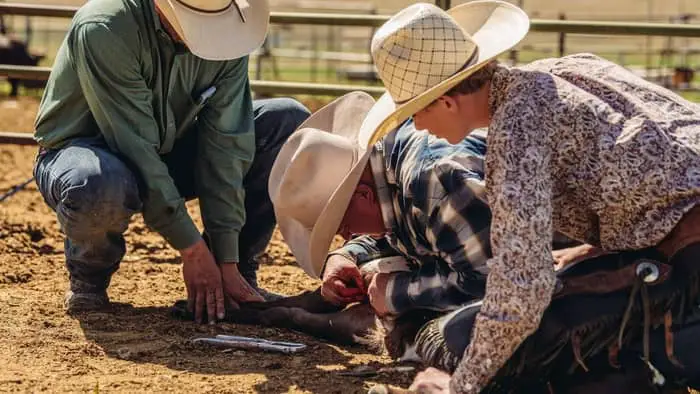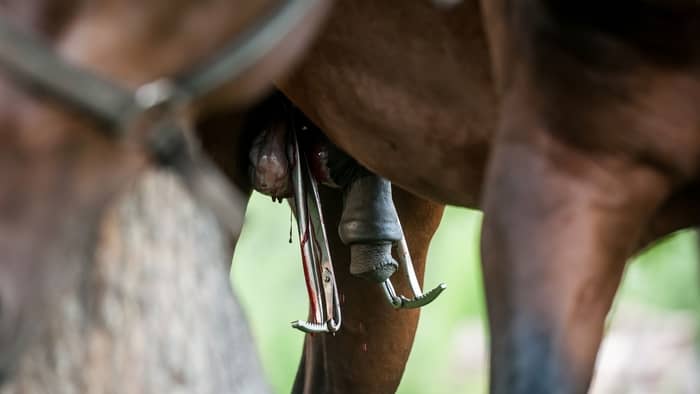Last Updated on January 12, 2022
If you have a young male horse, you might be considering getting him castrated. However, your veterinarian may discuss the advantages and disadvantages of several different horse castration techniques. So, when it comes to closed vs open vs semi-open castration in horses, which is best?
As a horse owner, you will want to make sure that your horse is getting the best possible veterinary care. Let’s take a look at why horses should be castrated and the different techniques that are used.
Why Is Horse Castration Necessary?
In any equine veterinary center, horse castration is one of the most commonly performed surgical procedures. This procedure may also be referred to as neutering or gelding a horse.
The vast majority of male horses are castrated unless they have desirable characteristics for breeding. An unneutered male horse – a stallion – is difficult to handle and manage, and requires a home with expertise in managing breeding horses. When neutered, a male horse becomes much more pleasant to live with, and they also have an improved quality of life.
The process of castration in horses takes away their ability to reproduce, as sperm production ceases. It also stops the production of testosterone, a hormone that is responsible for a high reproductive drive of a stallion. Once castrated a male horse is called a gelding.
Occasionally a horse may be castrated for medical reasons, such as testicular disease or tumors.
What Are The Techniques Performed For Castration Of Horse?

The process of castration involves a surgical procedure to remove both of the horse’s testicles. This is generally considered to be a minor procedure with minimal risks to the horse. However, as with all surgical procedures, some complications can occur.
It is important that the horse is correctly anesthetized before castration takes place. Some veterinarians favor standing sedation and local anesthesia. Others will castrate horses under full general anesthetic.
The most common techniques for castration horses all involve the use of surgical emasculators. This surgical instrument clamps and crushes the tissue that connects the testicle to the body. The testicle can then be removed with minimal risk of bleeding.
Emasculator 33CM, Castration, Large Animals, Horse, Cattle, Bulls
Closed Vs Open Vs Semi-Open Castration In Horses
However, there are some slight variations in the techniques that veterinarians use for castrating horses. These three techniques are called open, closed, or semi-closed castration. Let’s take a look at the differences between each technique, and its advantages and disadvantages.
What is open castration?
An open castration is one where the surgical site is not sutured closed. The wound is left open and will heal gradually over a period of time.
This is the most popular technique for horse castration, as it can be carried out under standing sedation. A local anesthetic is injected into the testicles to minimize pain and sensation.
To castrate a horse using the open technique, an incision is made in the scrotum – the sac surrounding the testicles. Each testicle is pushed through the incision and the emasculators are used to crush and cut the tissue connecting the testicle to the body.
Veterinarians and horse owners favor this technique as it can be carried out either at the clinic or in the horse’s home environment. Very little specialist equipment is required and the horse normally recovers quickly with minimal complications.
However, there are some small risks associated with open castration in horses. Because the tissues and incision site are not sutured closed, there is the possibility that bleeding could occur. There is also a greater risk that the incision site could become infected, as dirt and bacteria can enter the wound.
The other potential complication with open castration in horses is much more serious, but also very rare. This is called eventration when the small intestine descends down the inguinal canal and out through the surgical site. This is a potentially life-threatening problem and requires immediate emergency treatment.
What is closed castration?
In a closed castration, the testicles are removed using the same technique as an open castration, but the surgical site is sutured closed. Ligatures are also placed around the tissue connecting the testicle to the body to reduce the chance of bleeding. Because this technique is more complex, it can only be carried out on horses under general anesthetic.
A closed castration is less likely to result in post-operative complications such as bleeding or infection. However, general anesthesia involves other risks to the horse, and should not be undertaken without serious consideration. Closed sedation may also be more expensive than open castration.
Closed castration is the technique of choice for older stallions that are at a higher risk of bleeding. If you have a horse that has a partially descended testicle, your veterinarian may recommend closed castration.
What is semi-open castration?
A semi-open castration combines these two techniques, and the scrotum is partially sutured closed. This technique is less common but is thought to reduce the risk of eventration and infection. However, this technique is difficult to perform under standing sedation.
Open Vs Closed Vs Semi-Open Castration In Horses – Which Is Best?

So, now you know all about these techniques, how do you decide which is best for you and your horse? As a general rule, younger horses with both testicles descended are castrated using the open technique under standing sedation. The closed technique is preferable for older stallions, or horses that have a partially descended testicle.
One big advantage to open castration is that it can be done at home under standing sedation. This can be far less stressful for you and your horse than a trip to the veterinary clinic!
Read more about How Much Does It Cost To Geld A Horse?
Summary
So, as we have learned, when it comes to closed vs open vs semi-open castration in horses, the best technique depends on the age and temperament of your horse. Most young horses will be castrated using an open technique under standing sedation. A closed technique under general anesthesia is normally safer for older horses.
We’d love to hear your thoughts! Have you ever seen a horse being castrated? Or maybe you have some questions about closed vs open vs semi-open castration in horses? Leave a question below and we’ll get back to you!

Kate Chalmers is a qualified veterinary nurse who has specialized in horse care for the vast majority of her career. She has been around horses since she was a child, starting out riding ponies and helping out at the local stables before going on to college to study Horse Care & Management. She has backed and trained many horses during her lifetime and competed in various equestrian sports at different levels.
After Kate qualified as a veterinary nurse, she provided nursing care to the patients of a large equine veterinary hospital for many years. She then went on to teach horse care and veterinary nursing at one of the top colleges in the country. This has led to an in-depth knowledge of the care needs of horses and their various medical ailments, as well as a life-long passion for educating horse owners on how to provide the best possible care for their four-legged friends.
Kate Chalmers BSc (Hons) CVN, Dip AVN (Equine) Dip HE CVN EVN VN A1 PGCE
